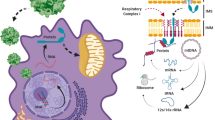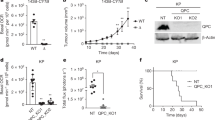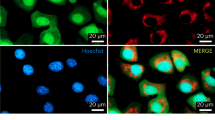Abstract
Suicide gene therapy (SGT) is a promising strategy for treating cancer. In this work, we show that thymidine phosphorylase (TP) deficiency, the underlying genetic defect in mitochondrial neurogastrointestinal encephalomyopathy (MNGIE), presents an opportunity to apply SGT using capecitabine, a commonly used prodrug that is converted into 5-fluorouracil by TP. Using an immortalised B-lymphoblastoid cell line from a patient with MNGIE, the tumourigenic EL-4 cell line, lentiviral vectors encoding TP and a double knockout (Tymp−/−Upp1−/−) murine model, we found that EL-4 cell-derived TP+ tumours were exquisitely sensitive to capecitabine and generated a significant local bystander effect. In addition, we detected a spontaneous cytolytic immune response in a significant fraction of the animals surviving more than 20 days after termination of the therapy. These data indicate that, in individuals lacking TP expression, TP is a highly specific suicide gene, which can be used to treat tumours that could hypothetically arise in MNGIE patients undergoing gene therapy, as these tumours will likely originate from the gene-modified cells and will be selectively targeted by capecitabine. These observations have important implications for gene therapy for MNGIE.
This is a preview of subscription content, access via your institution
Access options
Subscribe to this journal
Receive 12 print issues and online access
$259.00 per year
only $21.58 per issue
Buy this article
- Purchase on Springer Link
- Instant access to full article PDF
Prices may be subject to local taxes which are calculated during checkout





Similar content being viewed by others
References
Wang GP, Garrigue A, Ciuffi A, Ronen K, Leipzig J, Berry C et al. DNA bar coding and pyrosequencing to analyze adverse events in therapeutic gene transfer. Nucleic Acids Res 2008; 36: e49.
Lopez LC, Akman HO, Garcia-Cazorla A, Dorado B, Marti R, Nishino I et al. Unbalanced deoxynucleotide pools cause mitochondrial DNA instability in thymidine phosphorylase-deficient mice. Hum Mol Genet 2009; 18: 714–722.
Torres-Torronteras J, Gomez A, Eixarch H, Palenzuela L, Pizzorno G, Hirano M et al. Hematopoietic gene therapy restores thymidine phosphorylase activity in a cell culture and a murine model of MNGIE. Gene Therapy 2011; 18: 795–806.
Rivat C, Santilli G, Gaspar HB, Thrasher AJ . Gene therapy for primary immunodeficiencies. Hum Gene Ther 2012; 23: 668–675.
Simpson E, Scott D, James E, Lombardi G, Cwynarski K, Dazzi F et al. Minor H antigens: genes and peptides. Eur J Immunogenet 2001; 28: 505–513.
Lu M, Freytag SO, Stricker H, Kim JH, Barton K, Movsas B . Adaptive seamless design for an efficacy trial of replication-competent adenovirus-mediated suicide gene therapy and radiation in newly-diagnosed prostate cancer (ReCAP Trial). Contemp Clin Trials 2011; 32: 453–460.
Bonini C, Ferrari G, Verzeletti S, Servida P, Zappone E, Ruggieri L et al. HSV-TK gene transfer into donor lymphocytes for control of allogeneic graft-versus-leukemia. Science 1997; 276: 1719–1724.
Walko CM, Lindley C . Capecitabine: a review. Clin Ther 2005; 27: 23–44.
Ajani J . Review of capecitabine as oral treatment of gastric, gastroesophageal, and esophageal cancers. Cancer 2006; 107: 221–231.
Longley DB, Harkin DP, Johnston PG . 5-fluorouracil: mechanisms of action and clinical strategies. Nat Rev Cancer 2003; 3: 330–338.
Haraguchi M, Miyadera K, Uemura K, Sumizawa T, Furukawa T, Yamada K et al. Angiogenic activity of enzymes. Nature 1994; 368: 198.
Ciccolini J, Evrard A, Cuq P . Thymidine phosphorylase and fluoropyrimidines efficacy: a Jekyll and Hyde story. Curr Med Chem Anticancer Agents 2004; 4: 71–81.
Schwartz EL, Baptiste N, Wadler S, Makower D . Thymidine phosphorylase mediates the sensitivity of human colon carcinoma cells to 5-fluorouracil. J Biol Chem 1995; 270: 19073–19077.
Evrard A, Cuq P, Robert B, Vian L, Pelegrin A, Cano JP . Enhancement of 5-fluorouracil cytotoxicity by human thymidine-phosphorylase expression in cancer cells: in vitro and in vivo study. Int J Cancer 1999; 80: 465–470.
Morita T, Matsuzaki A, Tokue A . Enhancement of sensitivity to capecitabine in human renal carcinoma cells transfected with thymidine phosphorylase cDNA. Int J Cancer 2001; 92: 451–456.
Evrard A, Cuq P, Ciccolini J, Vian L, Cano JP . Increased cytotoxicity and bystander effect of 5-fluorouracil and 5-deoxy-5-fluorouridine in human colorectal cancer cells transfected with thymidine phosphorylase. Br J Cancer 1999; 80: 1726–1733.
Hacein-Bey-Abina S, Garrigue A, Wang GP, Soulier J, Lim A, Morillon E et al. Insertional oncogenesis in 4 patients after retrovirus-mediated gene therapy of SCID-X1. J Clin Invest 2008; 118: 3132–3142.
Ishitsuka H, Miwa M, Takemoto K, Fukuoka K, Itoga A, Maruyama HB . Role of uridine phosphorylase for antitumor activity of 5′-deoxy-5-fluorouridine. Gann 1980; 71: 112–123.
Cao D, Ziemba A, McCabe J, Yan R, Wan L, Kim B et al. Differential expression of uridine phosphorylase in tumors contributes to an improved fluoropyrimidine therapeutic activity. Mol Cancer Ther 2011; 10: 2330–2339.
Andreetta C, Puppin C, Minisini A, Valent F, Pegolo E, Damante G et al. Thymidine phosphorylase expression and benefit from capecitabine in patients with advanced breast cancer. Ann Oncol 2009; 20: 265–271.
Eda H, Fujimoto K, Watanabe S, Ura M, Hino A, Tanaka Y et al. Cytokines induce thymidine phosphorylase expression in tumor cells and make them more susceptible to 5′-deoxy-5-fluorouridine. Cancer Chemother Pharmacol 1993; 32: 333–338.
Schwartz EL, Hoffman M, O'Connor CJ, Wadler S . Stimulation of 5-fluorouracil metabolic activation by interferon-alpha in human colon carcinoma cells. Biochem Biophys Res Commun 1992; 182: 1232–1239.
Ciccolini J, Peillard L, Evrard A, Cuq P, Aubert C, Pelegrin A et al. Enhanced antitumor activity of 5-fluorouracil in combination with 2'-deoxyinosine in human colorectal cell lines and human colon tumor xenografts. Clin Cancer Res 2000; 6: 1529–1535.
Endo M, Shinbori N, Fukase Y, Sawada N, Ishikawa T, Ishitsuka H et al. Induction of thymidine phosphorylase expression and enhancement of efficacy of capecitabine or 5′-deoxy-5-fluorouridine by cyclophosphamide in mammary tumor models. Int J Cancer 1999; 83: 127–134.
Ma T, Zhu ZG, Ji YB, Zhang Y, Yu YY, Liu BY et al. Correlation of thymidylate synthase, thymidine phosphorylase and dihydropyrimidine dehydrogenase with sensitivity of gastrointestinal cancer cells to 5-fluorouracil and 5-fluoro-2'-deoxyuridine. World J Gastroenterol 2004; 10: 172–176.
Wang T, Wang L, Qian X, Yu L, Ding Y, Liu B . Relationship between gene expression of 5-fluorouracil metabolic enzymes and 5-fluorouracil sensitivity in primary cancer cells isolated from malignant ascites. Cancer Invest 2011; 29: 130–136.
Zhuo LJ, Gao MQ, Huang AM . [Improved sensitivity of gastric carcinoma cells to fluorouracil-related drugs by transfection of thymidine phosphorylase gene]. Zhonghua Bing Li Xue Za Zhi 2011; 40: 330–333.
Ciccolini J, Fina F, Bezulier K, Giacometti S, Roussel M, Evrard A et al. Transmission of apoptosis in human colorectal tumor cells exposed to capecitabine, Xeloda, is mediated via Fas. Mol Cancer Ther 2002; 1: 923–927.
Vincent J, Mignot G, Chalmin F, Ladoire S, Bruchard M, Chevriaux A et al. 5-Fluorouracil selectively kills tumor-associated myeloid-derived suppressor cells resulting in enhanced T cell-dependent antitumor immunity. Cancer Res 2010; 70: 3052–3061.
Bradford MM . A rapid and sensitive method for the quantitation of microgram quantities of protein utilizing the principle of protein-dye binding. Anal Biochem 1976; 72: 248–254.
Eixarch H, Gomez A, Kadar E, George M, Martinez N, Espejo C et al. Transgene expression levels determine the immunogenicity of transduced hematopoietic grafts in partially myeloablated mice. Mol Ther 2009; 17: 1904–1909.
Acknowledgements
This work was supported by the Instituto de Salud Carlos III (grant PI12/00322 to RM), and the United Mitochondrial Disease Foundation (postdoctoral grant 12-029 to JT). We thank Alex Rojo and Marta Rosal (VHIR animal facility) for their help with the in vivo experiments. We also thank María José Carreras for providing the capecitabine for the in vivo experiments.
Author information
Authors and Affiliations
Corresponding author
Ethics declarations
Competing interests
The authors declare no conflict of interest.
Additional information
Supplementary Information accompanies this paper on Gene Therapy website
Supplementary information
Rights and permissions
About this article
Cite this article
López-Estévez, S., Ferrer, G., Torres-Torronteras, J. et al. Thymidine phosphorylase is both a therapeutic and a suicide gene in a murine model of mitochondrial neurogastrointestinal encephalomyopathy. Gene Ther 21, 673–681 (2014). https://doi.org/10.1038/gt.2014.41
Received:
Revised:
Accepted:
Published:
Issue Date:
DOI: https://doi.org/10.1038/gt.2014.41



